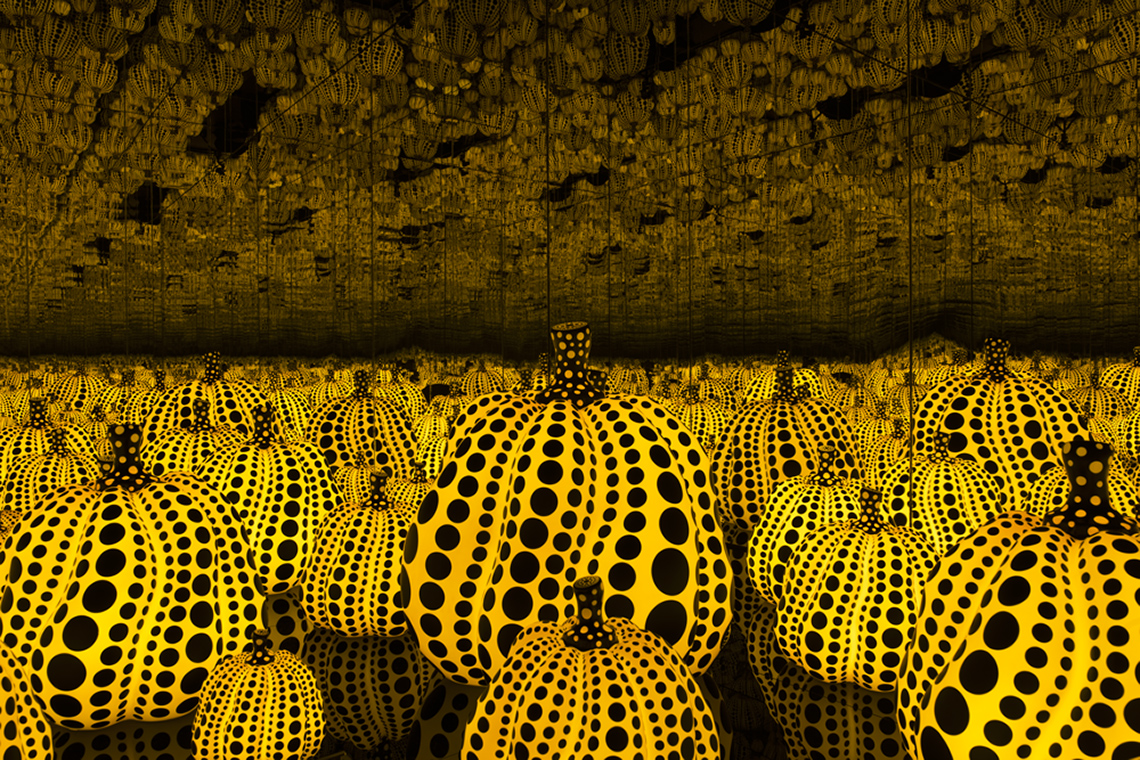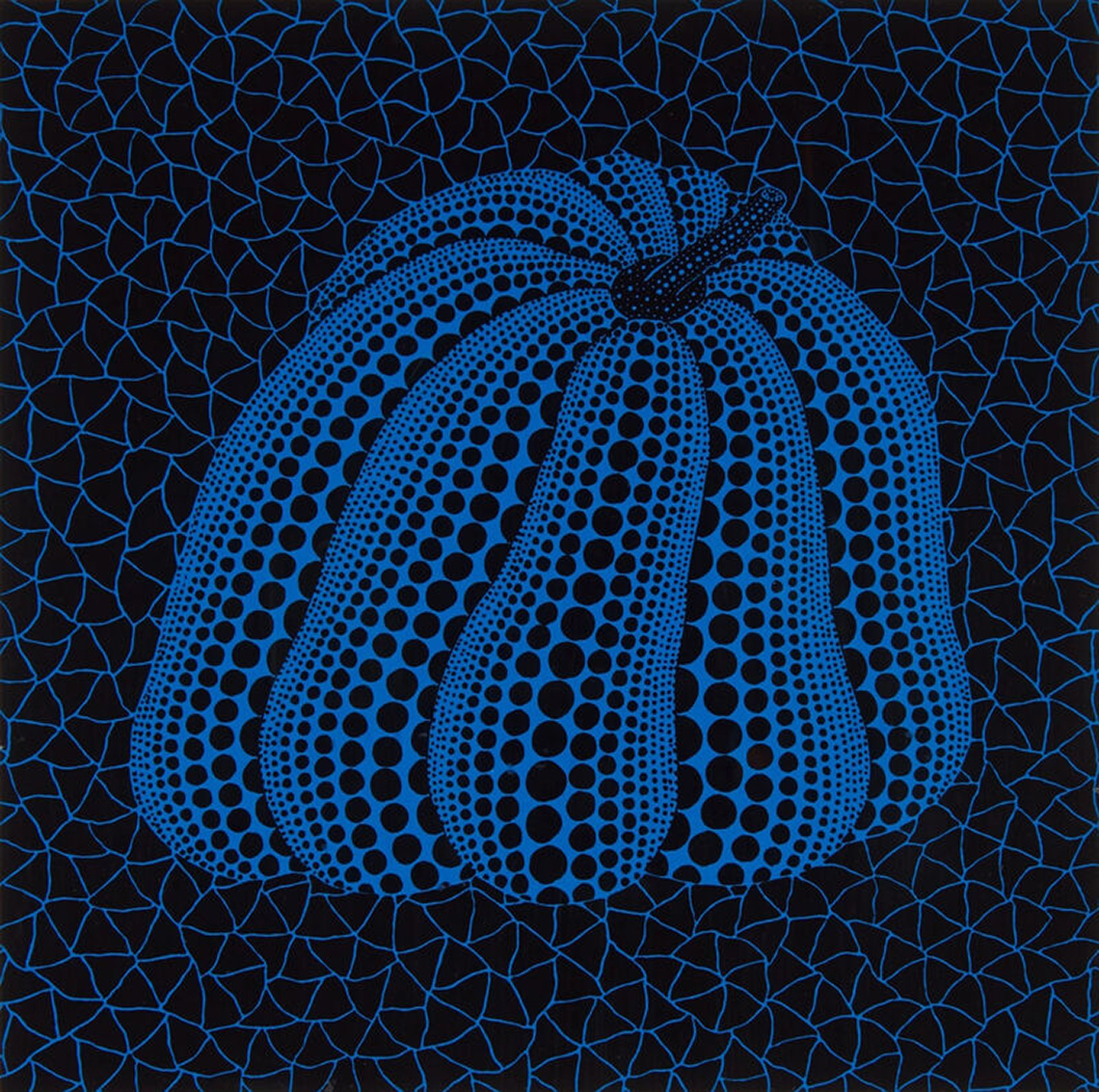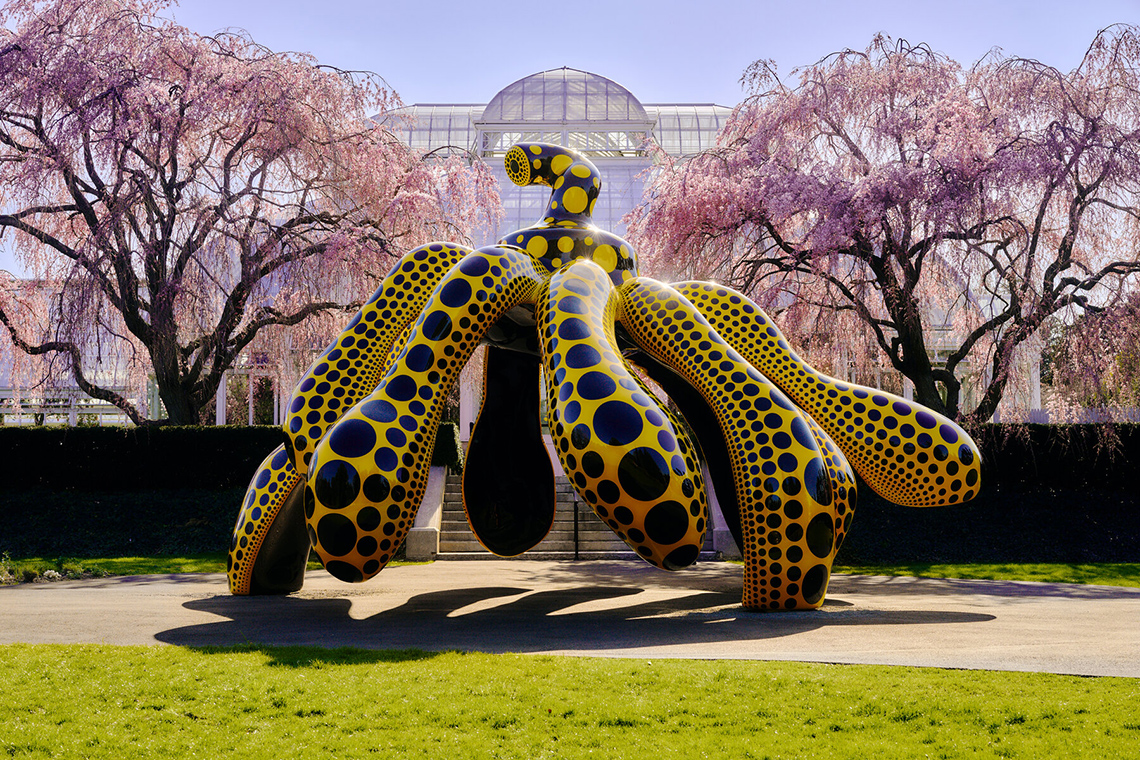Minds On
Let’s get started!
Explore the following image of an art piece called All the Eternal Love I Have for the Pumpkins by artist Yayoi Kusama.
What do you notice about the artwork?
Press ‘Hint’ to access a clue to help you get started.
Think about the shapes and lines.
What do you wonder about the artwork?
Use a method of your choice to record your responses.

All the Eternal Love I Have for the Pumpkins by Yayoi Kusama, 2016
This image of many pumpkins, each being slightly different sizes. Each of the pumpkins are yellow with rows of dots in lines from the top of the pumpkin to the bottom. Each dot in the line is the same size. Some are small and some are large.
Action
Get ready, get set…
In the Minds On, you explored an image of an art piece by artist Yayoi Kusama. Let’s find out more about this artist.
Yayoi Kusama

Yayoi Kusama was born on March 22, 1929 in Matsumoto, Japan. She began creating art from a young age. She enjoys painting and making sculptures. Pumpkins and polka dots are some of her favourite symbols to create with.
Symbols and art
Some artists have a personal style or symbol that they use when creating their artwork.
What is a symbol?
Press ‘Symbol’ to reveal the meaning for this word.
A symbol used in art might be a shape, object, living thing, etc. that represents a meaning or feeling to the artist.
For example, a lightbulb might mean thinking or a heart might mean love.

A symbol that Yayoi Kusama uses in her artwork is pumpkins. When Yayoi Kusama was young, her grandfather took her to a place where she saw pumpkins for the first time.
Why does Yayoi Kusama like pumpkins? She is drawn to their shape and says they have a warm and human-like feel to them.
Now let’s explore the pumpkin symbol that Yayoi Kusama uses so often in her artwork.
Explore the following images that showcase some of Yayoi Kusama’s pumpkin art.

Pumpkin (BSQ) by Yayoi Kusama, 1988
Black background covered with connected blue-outlined, organic-shaped, triangular shapes. In the centre, a large, blue, organic-shaped, pumpkin shape filled with black dots. Each section of the pumpkin has curved, vertical lines made up of dots starting with the centre line having the largest dots and as the lines spread out to either side, the dots get smaller with each line.

Pumpkin (YSQ) by Yayoi Kusama, 1998
Black background covered with connected orange-outlined, organic-shaped, triangular shapes. In the centre, a large, orange, organic-shaped, pumpkin shape filled with black dots. Each section of the pumpkin has curved, vertical lines made up of dots starting with the centre line having the largest dots and as the lines spread out to either side, the dots get smaller with each line.
Within Yayoi Kusama’s pumpkin art, you might notice her use of dots, lines, shape and pattern.
Press the following tabs to access definitions for lines, shape, and pattern.
An element of design. The path left by a moving point, such as a pencil or a digital drawing tool. A mark that leads the audience’s attention in an artwork. Changing the kind of lines can be used to suggest diverse ideas, shapes, or emotions. For example, a horizontal line can feel calm.

A shape is an element of design. A shape is a form that is enclosed or outlined. For example, when three lines meet, they create the shape of a triangle. A shape has length and width. A shape can be created by line, value, colour and/or texture. Shape may be geometric or organic. Shapes may be positive or negative.

Art with a repeating design. The pattern can have lines and shapes. The pattern can have colour and texture.
Consider the following questions:
- What do you notice about the dots? What do you notice about the lines?
- What do you notice about the shape? What kind of shape is the pumpkin?
- What do you notice about the pattern?
Press ‘Let’s Check’ to reveal possible answers.
I notice that there are different sized circle-shaped dots. The dots form a pattern within each section of the pumpkin. Each section starts with large dots in the middle and then the dots get smaller as they spread to each side. The dots also form curved vertical lines that create a pattern. The pumpkin is an organic shape.
The pumpkin symbol makes Yayoi Kusama feel warm and she has happy memories of pumpkins as a child.
Pause and Reflect
Pause and reflect
How does Yayoi Kusama’s pumpkin art make you feel? Why?
Go!
Now it’s your turn!
You will notice another one of Yayoi Kusama’s pieces of pumpkin art. This sculpture is called Dancing Pumpkin. It is a bit different from the work that you have explored in the action section.
What do you notice?
What is a sculpture?
Art made in three dimensions. Art that has height, width and depth. Sculptures are often explored from all sides. Sculptures can be made out of a wide variety of materials. Sculpture materials can include clay, found objects, paper, plasticine, wire and wood.

Dancing Pumpkin by Yayoi Kusama, 2020
Yayoi Kusama’s “Dancing Pumpkin” (2020) in the exhibition “Kusama: Cosmic Nature” at the New York Botanical Garden. Credit…Heather Sten for The New York Times. Large, three-dimensional sculpture of an abstract pumpkin in a park like setting. The stem at the top is black with different sized yellow dots all over it. Each section of the pumpkin reaches outward perhaps to represents legs dancing. The sections have vertical lines made up of dots starting with the centre line having the largest dots and as the lines spread out to either side, the dots get smaller with each line.
After exploring Dancing Pumpkin, respond to the following questions using a method of your choice.
- What do you notice about the dots, lines, shape and patterns in the sculpture?
- How is this sculpture different from the other artwork you explored by Yayoi Kusama?
Press ‘Let’s Check’ to reveal a possible answer.
In this sculpture, Yayoi Kusama opened up the shape of the pumpkin so that it appears that the pumpkin is dancing. The other artwork in the Action section shares images of pumpkins that are closed.
Pause and Reflect
Pause and reflect
How does this piece of Yayoi Kusama’s art make you feel? Why?
Consolidation
Putting it all together


Throughout this learning activity, you have learned about:
- the Japanese artist Yayoi Kusama’s pumpkin art works
- the use of symbols in art
- the use of lines, shape and patterns in art
- how works of art can express personal feelings
Now it’s time to create your own artwork that contains the use of a symbol, lines and/or patterns.
Press ‘Symbol’ to access the meaning for this word.
A symbol used in art might be a shape, object, living thing, etc. that represents a meaning or feeling to the artist.
For example, a lightbulb might mean thinking or a heart might mean love.

Materials Needed
Materials needed
Possible materials you might need for this learning activity:
- a blank sheet of paper or an art journal
- drawing materials such as pencils or crayons
- an electronic tablet for drawing
- any other art materials you like to use
Safety
Always be sure to do your safety checks before you do an activity.
Before you begin, check:
Student Success
Exploring digital creation options
When you are considering digital creation options, explore the variety of digital applications available!
Note to teachers: See your teacher guide for collaboration tools, ideas and suggestions.
Now it’s your turn to create! Press the following tabs to check out a variety of methods to create your art. Choose one of the following options to try out!
Create a detailed description of what kind of symbol you would like to share in your artwork.
- What does this symbol mean to you?
Next, describe how you might use lines and shapes and/or colour to create patterns in your artwork.
Create a digital drawing using an application of your choice sharing a symbol that is important to you. Use lines, shapes and/or colour to create additional patterns in your artwork.
Start by planning what kind of art piece you will create.
- How will you use the design elements discussed in the learning activity?
Your artwork could be real or imaginary. Begin by planning how to include the design element. Decide if you are using this design element or that design element. Digitally create your piece using your plan!
Remember to include details that create the feeling or the message you would like to communicate.
Possible materials you might need for this learning activity:
- paper, construction paper, cardboard
- pencil and eraser
- a ruler
- paint, paintbrush and cup of water
Press the following tabs to follows the steps to create your symbol art.
First, choose a symbol you would like to include. It can be a symbol you have experienced or a symbol that you make up.
Decide where you would like to place the symbol in your work. Yayoi Kusama created pumpkins at the center of her prints. You may choose to include your symbol in the center, side, bottom or top of your page.
Create an outline of your symbol on your paper.

Next, incorporate the use of lines and shape to create patterns. You might use a ruler to create straight lines or create curved and/or zigzag lines. You might add different geometric and organic shapes to your design.

If you like, add colour to your design! If you are painting during this step, make sure to let your artwork to dry completely once you are complete.

Portfolio
Review your learning
Respond to the following questions using a method of your choice.
- What symbol did you choose? Why?
- How did you use line, shape and/or create patterns in your artwork?
- How does your artwork make you feel? Why?
Reflection
How do you feel about what you have learned in this activity? Which of the next four sentences best matches how you are feeling about your learning? Press the button that is beside this sentence.
I feel…
Now, record your ideas about your feelings using a voice recorder, speech-to-text, or writing tool.